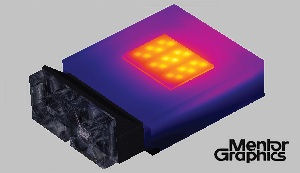Latest News
April 25, 2013
 |
Years ago when cellphones were radio phones about the size of an adobe brick, I set up a technical support line for a pre-Internet online service. In them days, modems were an honest to goodness peripheral about the size of a Guttenberg Bible, and a 1200-baud modem threw off so much heat you could warm leftovers on it. Countless times, baffled users would call-in complaining about “junk characters” spewing across their screens. I’d tell them give their modem some air. It was overheating because of the paper pile on top of it. They were always amazed that I knew what their office looked like. Fixed the issue every time too.
If only thermal management solutions would be that easy at the chip, material interface, and heat sink design level. Take LEDs. Even the single p-n junction in a power LED generates unwanted and unavoidable junction temperatures. Don’t handle it right, and the LED’s light output and color are lousy. With semiconductors, a few too many degrees of junction temperature can slice a device’s expected life in half. And if you don’t properly account for the different thermal expansion characteristics of disparate materials mating in an IC, they’ll ultimately degrade then destroy the device.
In short, thermal management is a big part of your electronic component or system design engineer’s lot in life. And you can expect more and more heat management problems affecting your design efforts because ours is a faster is better (and hotter) world. Which also happens to be the starting gate for today’s Check It Out white paper “Ten Good Reasons Why Thermal Measurements Are Important To Your Design,” written by Andras Poppe of Mentor Graphics.
This is a short paper, some 8 pages long, and it is well done. It approaches its highly complex subject with a technical matter-of-factness that’ll appeal to the semiconductor designer as well as any reasonably informed engineer whose duties only touch upon thermal management issues in electronic components from time to time.
Each of the 10 reasons is handled quickly in a “here’s a reason, here’s why it’s important to your design processes” format. The reasons called out range from the apparent to the sublime, such as insuring against premature product failures, complying with industry standards, creating higher quality products, refining and optimizing library models, publishing accurate (and verifiable) product data, and controlling environmental variables.
A particularly notable section addresses developing compact models for better simulations. This thermal management reason exposes one of the key elements of this paper: the synergy between physical and virtual testing. See, nominally this paper is collateral for the company’s MicReD T3Ster (say it “Trister”), a turnkey thermal measurement system for characterizing semiconductor device packages and electronic systems. But as is its wont, Mentor Graphics focuses on providing good engineering information, mentioning its products just a handful of times when necessary to illustrate a given discussion.
Here in this section, Poppe explains how a T3Ster can measure and graph the heat path from one resistance through a capacitance to another resistance. With this step-wise data acquired, you can evaluate the performance of individual materials and, eventually, have sufficient data to model the thermal impedance of the heat-flow path with a tool such as FloTHERM, Mentor Graphics’s CFD (computational fluid dynamics) software for electronic component applications.
Quite simply, this paper is filled with good, thought-provoking information presented cleanly and without hoopla. And that is what makes this an enjoyable read. Hit the link over there to download “Ten Good Reasons Why Thermal Measurements Are Important To Your Design.”
Thanks, Pal. – Lockwood
Anthony J. Lockwood
Editor at Large, Desktop Engineering
Read: Ten Good Reasons Why Thermal Measurements Are Important To Your Design
Subscribe to our FREE magazine, FREE email newsletters or both!
Latest News
About the Author
Anthony J. Lockwood is Digital Engineering’s founding editor. He is now retired. Contact him via [email protected].
Follow DE





